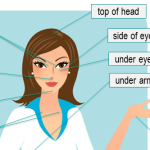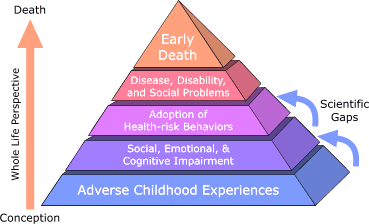 CLICK to BUY “Don’t Try This Alone”
CLICK to BUY “Don’t Try This Alone”
I’ve used Emotional Freedom Technique (EFT) aka Tapping for four years and gotten major relief from severe fight-flight emotions like fear and anger (emotions I could feel). I’ve also gotten relief from physical pain caused by “frozen” emotions I couldn’t feel. Click on diagram for full graphic “Where to Tap” by PCOSDiva.com. [FN1]
Please note: if you have overwhelming trauma, do NOT tap alone! Use a therapist or trained practitioner, or don’t tap; it’s not safe.
Also note: I’m making “I Statements,” not giving advice. These tools worked for me to heal traumatic feelings — but “your mileage may vary.”
What is tapping? In 1980 psychotherapist Dr. Roger Callahan “was working with a patient, Mary, for an intense water phobia, “ reports Gary Craig, Callahan’s student and creator of tapping. “She suffered frequent headaches and terrifying nightmares related to her fear of water… Dr. Callahan tried conventional means for a year and a half.” [FN2]
“Callahan had studied traditional Chinese medicine, which calls the body’s energy ‘ch’i’,” reports Nick Ortner, author of “The Tapping Solution.” “The Chinese discovered 100 meridian points along the body. They learned that by stimulating them, they could manipulate the body’s ch’i to heal symptoms and diseases.” Ortner’s website has a free e-book on tapping. [FN3]
One day with Mary in 1980, says Craig, “Callaghan… decided to tap with his fingertips under her eyes, an end point of the stomach meridian. This was prompted by her complaint of stomach discomfort. To his astonishment, she announced that her disturbing thoughts about water were gone, raced to a nearby swimming pool and began throwing water in her face. No fear. No headaches. It all went away….and has never returned.”
Craig codified Callahan’s process into a sequence of acu-points to tap. “You tap near the end points of numerous energy meridians without knowing which of them may be disrupted,” says Craig. This set of meridians seems to cover what we need to calm most emotions.
Tapping aims to replicate Mary’s experience. First, “focus on the negative emotion at hand: a fear or anxiety, a bad memory, an unresolved problem, or anything bothering you,” says Ortner, such as Mary did with her fear of water. Next, “while maintaining your mental focus on this issue, use your fingertips to tap 5-7 times each on 9 of the body’s meridian points.” These are nine spots on the hands, face, neck and upper torso easily accessible, even in public. (Diagram again at top.) It’s a non-invasive activation of some of the same spots targeted in acupuncture, but no needles.
Pseudoscience? Energy Disrupt? Amygdala Message?
 How to Tap is in Part 2, my next blog (or start with the links above).
How to Tap is in Part 2, my next blog (or start with the links above).
As to what it is, I was surprised that Wikipedia says tapping “has no benefit beyond the placebo effect,” is “pseudoscience and has not garnered significant support in clinical psychology.” [FN4]
“When she was experiencing fear, the energy flowing through her stomach meridian was disrupted,” Craig said of Mary. “That energy imbalance is what was causing her emotional intensity. Tapping under her eyes sent pulses through the meridian and fixed the disruption… It is accepted practice to ‘treat the memory’ and ask the client to repeatedly relive some emotionally painful event,” Craig says. “EFT, by contrast, respects the memory but addresses the true cause… a disruption in the body’s energy system.”
Books like “The Body Keeps the Score” by Bessel van der Kolk, and “Healing Trauma” by Peter Levine do say that healing traumatic emotions is about working with the body and the body-centered brain stem. Talking with the thinking brain about the horrible details of past trauma is often re-traumatizing, van der Kolk, Levine, et. al. warn. [FN 5]
When danger threatens or traumatic memories make our current situation “feel” dangerous, the brain’s amygdala sends out signals that stimulate cortisol, putting us into fight-flight. When we are thus emotionally “triggered,” we often go into a painful fight-flight panic.
Clinical psychologist David Feinstein and his Harvard colleagues have published studies (dismissed by Wikipedia) saying that both ancient acupuncture and tapping on acupressure points signal the amygdala to calm down. Feinstein believes both methods stimulate hormones which tell the amygdala that we are safe, so the amygdala stops the cortisol flood.
Or Just Feel My Feelings?
One thing is clear: if there were a tiger about to leap at me, I wouldn’t be sitting around tapping my forehead. Maybe tapping the forehead, under the nose, etc., is enough to tell the brain that our situation is safe.
To resolve trauma, says Dr. Dan Siegel, we must process traumatic emotions out of short-term memory where it feels like “this hurts now,” into long-term memory so we can feel “that was in the past.” One brain area pivotal to that processing is the hippocampus. But in fight-flight, the amygdala turns off the hippocampus, to save all our energy for fighting and fleeing. Maybe tapping keeps my hippocampus turned on?
Or maybe it’s simply this:
Tapping gives us license to do something for which our society has no room: sit with, accept, and fully feel through our feelings, which the yogis call self-compassion. Tapping actually trains us to do this, which usually allows our body to release these feelings; then suddenly we don’t feel so bad.
I’ve spent 5 years reading grief letters about my childhood trauma, using the rigorous Grief Recovery Handbook. Maybe folks who haven’t done all that, might not be able to access childhood feelings as I do when I tap.
But one thing for sure: in tapping, we focus on a bad feeling, and feel it, and accept it – rather than trying to suppress it.
If while feeling, it helps me to tap on a few ancient acupuncture points, no harm. Maybe having this finger-drumming as a structure allows me to trust that these emotions won’t overwhelm me? All I know is: when I tap, I almost always feel through a feeling. Then it dissipates and I get relief.
Next Time: Part 2: How to Tap.
———————————
Kathy’s blogs expand on her book “DON’T TRY THIS AT HOME: The Silent Epidemic of Attachment Disorder—How I accidentally regressed myself back to infancy and healed it all.” Watch for the continuing series each Friday, as she explores her journey of recovery by learning the hard way about Attachment Disorder in adults, adult Attachment Theory, and the Adult Attachment Interview.
Footnotes
FN1 http://pcosdiva.com/2013/05/the-benefits-of-eft-for-pcos/
FN2 Gary Craig’s EFT Manual: spiritual-web.comdownloadseftmanual.pdf.pdf
FN3 Nick Ortner’s website has a free e-book on tapping: http://www.thetappingsolution.com/free_tapping_ebook.html
FN4 http://en.wikipedia.org/wiki/Emotional_Freedom_Techniques#cite_note-Feinstein-4
FN5 Dr. Bessel van der Kolk, Dr. Peter A. Levine, Dr. Bruce Perry and others say in books like “The Body Keeps the Score” and “Healing Trauma” that healing trauma requires body work.
20,437 total views, 2 views today



In a nutshell is it about the body-work (healing) or brain-work (working through memories) ?
Which approach you tend to move towards more and see as more effective Gary or Peter and his colleague?
Pingback: Relieving Pain Naturally
Pingback: Do Most Breast Cancer Patients Develop PTSD? | Healthy Living and Happy Lifestyle
Thank you, I found this post when looking for something else. As a psychotherapist, I love the power of hypnosis, mindful practice and Emotional Freedom Techniques. Yes, I also use conventional therapies including cognitive behaviour therapy (CBT) but I find other modalities, especially EFT, puts the client in the driver’s seat, empowers them to heal themselves. Your overview of the genesis and principles of EFT is splendid and I’ll be adding it to client’s reading by providing links to you and your blog. As to your surprise about Wikipedia, I’m surprised when their articles are of an acceptable standard. Most of what now passes as ‘knowledge’ via Wikipedia, is unmediated and unmoderated opinion posing as fact.
Thank you, Darlene,
And yes, I watched two of Nick Ortner’s Tapping Summits when I first began tapping back in 2012. In my blog here, I’ve posted the link to Nick’s free ‘e-book’ on tapping; here it is again: http://www.thetappingsolution.com/free_tapping_ebook.html
I have found EFT very useful for relaxation and pain relief as well as for dealing with emotional and motivational blocks. There are many useful resources online–one of the best I’ve found for free resources is Nick Ortner’s site which sponsors a worldwide Tapping Summit each year (see http://www.thetappingsolution.com) . He has just released a new book on EFT for Pain Relief which is a sequel to his book The Tapping Solution.
Darlene Kordich Hall, PhD